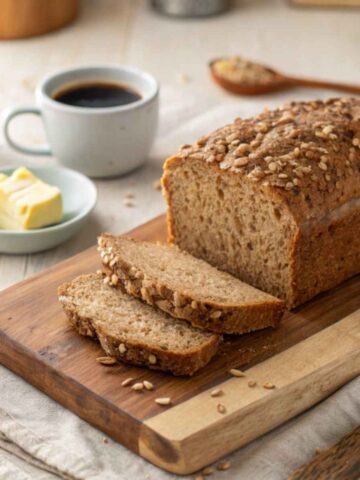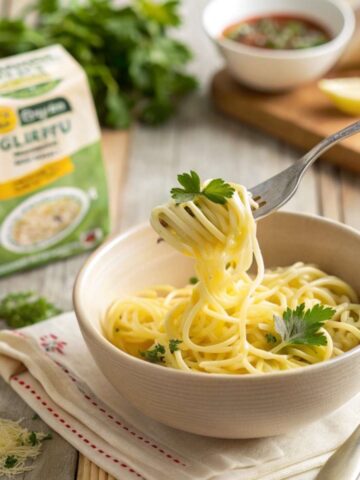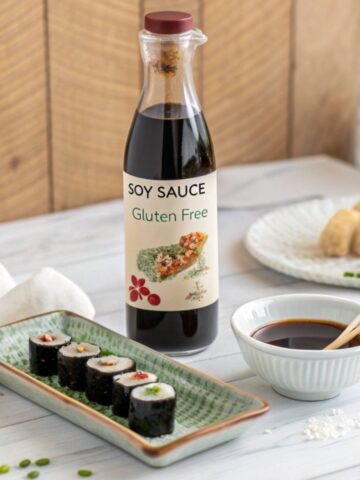Rice is a fundamental part of diets around the world. Whether you’re eating sushi, risotto, or a comforting bowl of rice pudding, this versatile grain is often a go-to ingredient for many meals. But if you’re following a gf diet, you might wonder: Is rice gluten free? In this article, we will answer that question and dive into the various types of rice, their health benefits, and how to incorporate rice into your gf lifestyle safely.
Jump to:
- What is Gluten?
- Is Rice Gluten Free?
- Types of Rice and Their Gluten-Free Status
- Cross-Contamination: Can Rice Be Contaminated with Gluten?
- How Cross-Contamination Occurs
- Tips for Avoiding Cross-Contamination with Rice
- Gluten-Free Varieties of Rice
- Nutritional Benefits of Rice
- Gluten-Free Diets and the Role of Rice
- How to Safely Prepare Gluten-Free Rice
- Gluten-Free Rice-Based Products
- Popular Gluten-Free Recipes with Rice
- How to Choose the Right Type of Rice for Your Meal
- Is Rice Healthy for a Gluten-Free Diet?
- Other Gluten-Free Grains You Can Use
- Conclusion
- FAQs
What is Gluten?
Definition of Gluten
Gluten is a protein in grains like wheat, barley, and rye. It gives dough its elasticity and helps baked goods maintain their shape. However, for people with celiac disease or non-celiac gluten sensitivity, consuming gluten can trigger harmful reactions, leading to digestive discomfort and other health issues.
Why Some People Need to Avoid Gluten
People with celiac disease must avoid gluten altogether, as even trace amounts can cause damage to their small intestines. Those with non-celiac gluten sensitivity may experience symptoms like bloating, headaches, and fatigue when they consume gluten. However, their immune system isn’t involved like that of celiac disease. For this reason, many people follow a gluten-free diet to improve their health and well-being.
Is Rice Gluten Free?
Types of Rice: White, Brown, Wild, and Others
The good news is that rice is naturally gluten-free, regardless of its type. Whether you prefer white rice, brown rice, or wild rice, you can enjoy this grain as part of your gluten-free diet.
Why Rice is Naturally Gluten-Free
Rice doesn’t contain gluten because it is not a wheat, barley, or rye family member. This makes it a safe option for those with gluten sensitivities. However, it’s essential to know how rice is processed and prepared, as cross-contamination with gluten can occur in some instances.
Types of Rice and Their Gluten-Free Status
There are many varieties of rice, and all of them are GF. Let’s take a closer look at some popular types:
White Rice
White rice is the most common type of rice. Processing removes the bran and germ, creating a softer texture and reducing cooking time. While white rice is lower in fiber than brown rice, it is still GF and an excellent base for many meals.
Brown Rice
Brown rice is a whole grain that retains its bran and germ layers. This gives it a nuttier flavor and a chewier texture than white rice. Brown rice is higher in fiber and nutrients, making it a healthy option for GF eaters.
Wild Rice
Wild rice isn’t technically rice but a grass seed that grows in aquatic areas. It has a distinctive chewy texture and earthy flavor, and like other types of rice, it is naturally GF.
Jasmine and Basmati Rice
Jasmine rice and Basmati rice are aromatic long-grain varieties. They are commonly used in Asian and Middle Eastern cuisines and are gluten-free.
Sushi Rice
Sushi rice is a short-grain variety used in sushi rolls. While the rice itself is gluten-free, sushi preparation must be cautious, as some sauces (like soy sauce) may contain gluten.
Cross-Contamination: Can Rice Be Contaminated with Gluten?
How Cross-Contamination Occurs
Even though rice is naturally gluten-free, it can sometimes become contaminated with gluten during processing or packaging. Processing rice in a facility that handles wheat, barley, or rye increases the risk of cross-contamination.
Tips for Avoiding Cross-Contamination with Rice
To minimize the risk of cross-contamination:
- Purchase rice labeled as certified gluten-free to ensure it was processed in a gluten-free facility.
- Store your rice in a separate container if you share a kitchen with gluten-containing foods.
- Be cautious of boxed or seasoned rice mixes, as they often contain gluten additives.
Gluten-Free Varieties of Rice
The Benefits of Choosing Certified Gluten-Free Rice
When choosing rice for your GF diet, looking for certified GF rice is best. The certification ensures that facilities process and package the rice in a dedicated gluten-free environment, reducing the risk of cross-contamination with gluten-containing grains.
Rice-Based GF Products
Rice is used to make a variety of GF products, including:
- Rice Flour: A versatile GF flour used in baking and cooking.
- Rice Pasta: Made from rice flour, rice pasta is a GF alternative to traditional wheat pasta.
- Rice Crackers: Light and crispy snacks made from puffed rice or rice flour, often available in GF varieties.
Nutritional Benefits of Rice
Rice is a Source of Energy and Carbohydrates
Rice is an excellent source of carbohydrates, making it a go-to grain for people who need quick energy. It’s also naturally low in fat and sodium, making it a healthy option when prepared without added oils or salt.
The Fiber Content in Brown Rice and Its Health Benefits
Brown rice is a whole grain with higher fiber than white rice. Fiber helps regulate digestion, supports heart health, and can help you feel full longer. This makes brown rice a healthier option for people looking to increase their fiber intake while following a GF diet.
Rice as a Naturally Fat-Free and Low-Sodium Option
If you want to reduce your intake of fats or sodium, rice is a naturally fat-free and low-sodium food. You can prepare rice in various ways without adding unhealthy fats or too much salt, making it a heart-healthy choice.
Gluten-Free Diets and the Role of Rice
Why Rice is a Go-To Grain for Gluten-Free Eaters
Rice is a staple in many gluten-free diets because it’s versatile, widely available, and affordable. It can be used as a base for various dishes, from savory stir-fries to sweet rice puddings. Its mild flavor pairs well with countless ingredients, making it easy to incorporate into meals.
The Versatility of Rice in a Gluten-Free Diet
Rice can be used in numerous ways to enhance a GF diet. Whether it's the base of your meal or a side dish, the versatility of rice makes it an easy addition to many GF recipes:
- Boiled or steamed: Rice is a perfect GF base for curries, stir-fries, and stews.
- Fried rice: Stir-fry leftover rice with vegetables, eggs, and a protein of your choice to transform it into a flavorful dish.
- Rice bowls: Combine rice with roasted vegetables, lean proteins, and sauces for a satisfying GF bowl.
- Rice cakes and snacks: These crispy GF treats are perfect for a quick snack.
- Rice flour: Used in baking for gluten-free breads, cakes, and cookies.
How to Safely Prepare Gluten-Free Rice
Steps to Prepare Rice Without Cross-Contamination
If you're following a strict GF diet, avoiding cross-contamination is essential when preparing rice. Here’s how to safely cook rice:
- Use clean cookware and utensils: Ensure that pots, pans, and utensils have been properly cleaned before using them to prepare gluten-containing foods.
- Separate rice storage: Store rice in a dedicated gluten-free container away from gluten-containing ingredients.
- Check water sources: If using water that has been in contact with gluten (like water used to cook pasta), do not use it to prepare your rice.
- Cook rice in a gluten-free environment: If possible, prepare your rice in a gluten-free zone to minimize cross-contact risk.
Importance of Keeping Cooking Surfaces Clean
Even trace amounts of gluten can cause issues for people with celiac disease. To avoid contamination, thoroughly clean countertops, cutting boards, and cooking appliances before preparing gluten-free rice.
Gluten-Free Rice-Based Products
Gluten-Free Rice Crackers and Cakes
Puffed rice or rice flour creates popular gluten-free snacks like rice crackers and cakes. They are light and crunchy and often come in a variety of flavors. They’re easy to find in the gluten-free aisle of most supermarkets.
Gluten-Free Rice Pasta
For those missing traditional pasta, rice pasta is an excellent gluten-free alternative. Made from rice flour, rice pasta offers a texture similar to wheat-based pasta and works well in dishes like spaghetti, lasagna, or macaroni and cheese.
Using Rice Flour in Gluten-Free Baking
Rice flour is a versatile ingredient in gluten-free baking. People commonly use rice flour in gluten-free bread, cookies, and cakes. It provides structure to baked goods and combines well with other gluten-free flours, like almond or coconut flour, for even better results.
Popular Gluten-Free Recipes with Rice
Here are some delicious GF rice recipes that you can try at home:
Gluten-Free Risotto
Risotto, a creamy Italian dish made with Arborio rice, is naturally GF and can feature flavors from vegetables, herbs, and meats.
Ingredients:
- 1 cup arborio rice
- One onion, finely chopped
- 4 cups gluten-free chicken or vegetable broth
- 1/2 cup white wine
- 1/4 cup parmesan cheese
- Salt and pepper to taste
Instructions:
- In a pan, sauté the onions in olive oil until soft.
- Add the arborio rice and stir until coated.
- Add the broth gradually, one ladle at a time, and stir constantly until the liquid absorbs.
- Continue until the rice is tender, then stir in parmesan cheese and season with salt and pepper.
Gluten-Free Rice Pudding
Rice pudding is a comforting and creamy dessert that’s naturally GF.
Ingredients:
- 1 cup cooked white rice
- 2 cups milk (or dairy-free alternative)
- 1/4 cup sugar
- 1 teaspoon vanilla extract
- 1/4 teaspoon cinnamon
Instructions:
- Combine rice, milk, sugar, and vanilla over medium heat.
- Cook, stirring occasionally, until the mixture thickens and becomes creamy.
- Sprinkle with cinnamon and serve warm or chilled.
Rice Bowls with Veggies and Protein
You can easily customize rice bowls as a GF meal with your favorite ingredients. Use jasmine or basmati rice and top with a protein like grilled chicken or tofu, then add fresh or roasted vegetables and drizzle with your favorite GF sauce.
How to Choose the Right Type of Rice for Your Meal
Differences Between Short, Medium, and Long-Grain Rice
Choosing the correct type of rice depends on the texture and flavor you’re aiming for in your dish.
- Short-grain rice: Sticky and soft, ideal for sushi or rice pudding.
- Medium-grain rice: Tender and slightly sticky, perfect for dishes like risotto.
- Long-grain rice: Light and fluffy when cooked, making it great for side dishes, pilafs, and stir-fries.
How Different Rice Types Affect the Flavor and Texture of Your Dishes
Each type of rice has its own texture and flavor profile. For example, jasmine rice is fragrant and soft, while basmati rice is aromatic and fluffy. Experimenting with different varieties will allow you to find the perfect rice for your GF meals.
Is Rice Healthy for a Gluten-Free Diet?
Nutritional Comparisons: White vs. Brown Rice
When deciding between white and brown rice, consider the nutritional differences:
- Due to processing, white rice is lower in fiber and nutrients but cooks faster and has a softer texture.
- Brown rice: A whole grain that retains its bran and germ, making it higher in fiber, vitamins, and minerals. It has a nuttier flavor and chewier texture than white rice.
Rice and Blood Sugar Management
Because rice is high in carbohydrates, people with diabetes or those looking to manage their blood sugar levels may opt for brown or wild rice, which has a lower glycemic index than white rice. Pairing rice with fiber-rich vegetables and lean proteins can help stabilize blood sugar levels.
Other Gluten-Free Grains You Can Use
Suppose you’re looking to add variety to your gluten-free diet. In that case, several other grains can serve as rice alternatives.
Quinoa as a Rice Alternative
Quinoa is a gluten-free seed that’s high in protein and fiber. You can use it instead of rice in most recipes, as it provides a similar texture with a slightly nutty flavor.
Gluten-Free Grains Like Millet and Sorghum
Millet and sorghum are other GF grains that can be used as alternatives to rice. Both grains are nutrient-dense and provide different textures and flavors to meals. You can use them in soups, salads, and side dishes, making them versatile.
Conclusion
Rice, a naturally GF grain, easily fits into a GF diet. Whether you prefer white, brown, or wild rice, there are endless ways to enjoy this versatile ingredient. From savory rice bowls to sweet rice puddings, rice remains a staple food for GF eaters worldwide. Avoiding cross-contamination with gluten is essential when preparing rice, especially if you have celiac disease or severe gluten sensitivity. You can enjoy rice without worry by choosing certified GF rice and following safe preparation practices.
FAQs
Yes, rice can be cross-contaminated with gluten during processing or packaging if handled in the same facility as wheat, barley, or rye. To avoid this, look for rice labeled as certified gluten-free.
All rice varieties are naturally gluten-free. The best type depends on your taste and the dish you're preparing. Brown rice offers more fiber, while white rice has a milder flavor and softer texture.
Some flavored or pre-seasoned rice mixes may contain gluten, so always check the ingredient list for any additives like malt flavoring or wheat starch.
Yes, you can safely eat rice if you have celiac disease, as long as it has not been cross-contaminated with gluten. Choose certified gluten-free rice to be sure.
Identifying gluten contamination in rice by appearance alone is challenging. Choose rice labeled as certified gluten-free to ensure it is processed in a gluten-free facility.





Leave a Reply